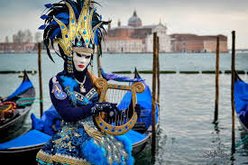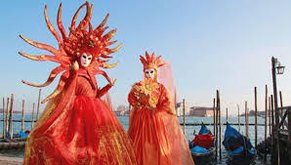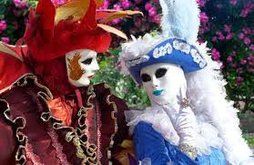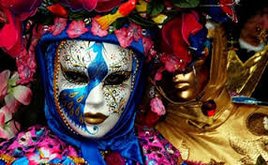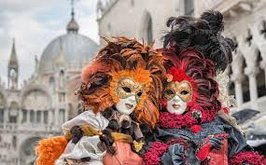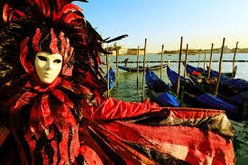
MASQUERADE FESTIVALS IN EUROPE
CARNIVAL IN GALICIA
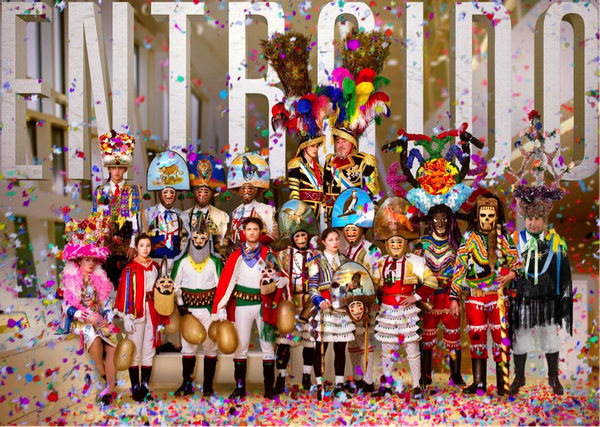
by Ana Arias Santiago & Laura Rodicio Pereira
The origins of our Entroido, our Carnival are not clear. Some find it related to prehistory magical ceremonies and compare it to tribal totemic dances. Others refer to a Roman origin in the Lupercalia festivals. But in general it has been connected to the Christian calendar. Carnival takes place just before Lent, a time to fast and pray. All over Galicia there are different displays of this festival. We are going to have a look at the most outstanding ones.
The carnival in Ourense is well known and within this province we must highlight the so called magical triangle of three places, Verin, Xinzo and Laza. In Xinzo they experience the longest carnival in Spain, as they party for longer than a month, beginning with a battle of flour and finishing five weeks later. The local character is the “pantalla”, which takes to the streets to keep order and make sure that everyone is wearing a costume.
The ruler in Verín is the “cigarron”. This carnival begins with a males only Thursday, followed by a females only festival and finishes with a parade on Sunday, two weeks later.
Laza boasts about having the most genuine carnival in Galicia. The "peliqueiros" here take up the baton, in a costume which can weigh up to twenty-five kilos.
There are also other outstanding carnivals in the province, such as in Viana do Bolo, where it is connected to the sound of drums and a food festival. The protagonists are the "boteiros", whose task is to open the way with a colouful stick for the “folion”, the parade of drummers.
Very near there, in Manzaneda, the "mázcara" is the central character, even though they go barefaced. They are skilled dancers who parade one village after another in the company of drummers.
Outside the Ourense province there are also other carnivals with a long tradition. In Pontevedra the "madamas" and "galanes" are the typical characters of carnival in Cobres, Vilaboa.
But maybe the most singular carnival is in the area of the river Ulla, where the generals, the Xenerais, make fun of war in remembrance of the invasions of Napoleon or even the Carlist Wars.
The Bear of Salcedo is the characteristic mask of this place in Lugo for carnival, which takes place on Monday and celebrates the beginning of spring, evoking the moment when the bear emerges from the den after winter hibernation. It symbolizes in this way the beginning of the annual agricultural cycle, propitiatory of abundat harvests and the fertility of women.
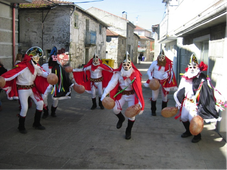
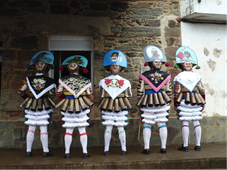
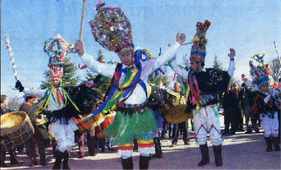
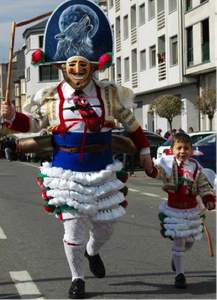
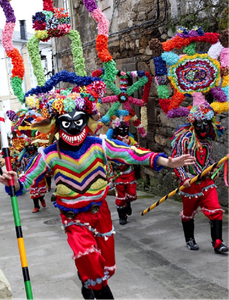
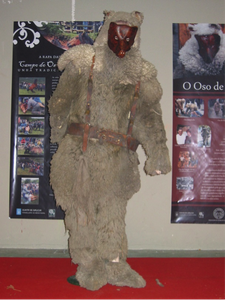
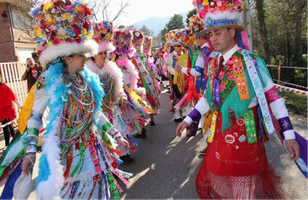
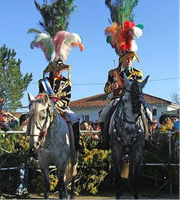

Kukeri Days in Bulgaria
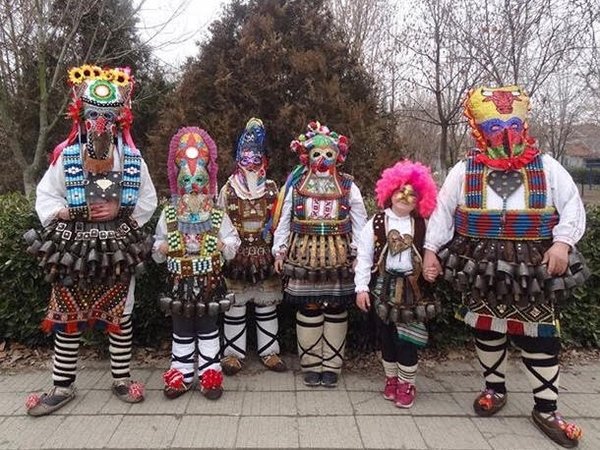
Kukeri is a traditional Bulgarian ritual of masked men with costumes intended to scare away the evil spirits, celebrated couple of days every year after New Year and before Lent (usually late January to early March).
The custom is related to the Thracian Dionysus cult in the wider area of Thracia thus similar rituals are found in both Turkish and Greek part of the Balkans. However, it has its most lavish celebration in Bulgaria with numerous festivals in different part of the country, representing the variety of masks, costumes and specific rituals.
Although being a Thracian ritual, the word “kuker” comes from Latin (“cuculla” meaning a “hood”) and it denotes a folkloric monster, a man dressed in an elaborate suit of fur and ribbons, feathers and beads. The kukeri wear carved masks with faces of beasts and birds; hanging heavy copper or bronze bells around their waists as they dance and jump in arcane rituals intended to dispel the evil spirits which might otherwise bring bad luck to the community.
The ritual starts early in the morning, the dancing kukeri go through the village, from house to house, bringing health, happiness and a bountiful harvest year. This is a celebration of the upcoming spring as well, when evil should be vanished and new life be born. During the festival rituals like ploughing and sowing are also performed. There is always the family with the pregnant wife with the new baby being born at the end of the ritual.
The village of Kabile has long tradition in performing this ritual, being also the place where the International Festival “Kukerland” starts every year. The beautifully made costumes and amazing masks are specific for the area of the village, making them unique in Bulgaria. Kukeri Days are celebration of everyone especially the children who take part together with their fathers in this amazing ritual.
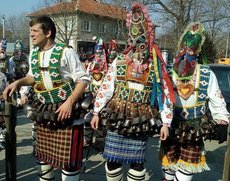
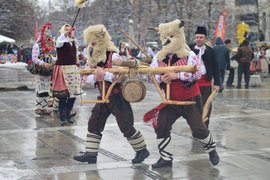
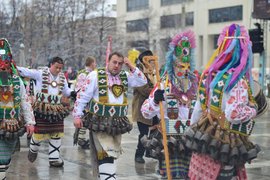
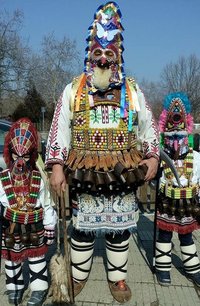
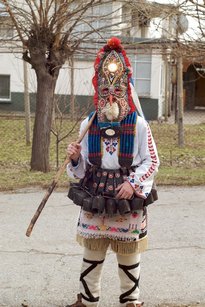

Masquerade festivals in the UK
From Hogmanay in Edinburgh to Pride in Brighton, Britain is home to a whole range of excellent festivals and events throughout the year. However, we will look at just few as they represent one of the most significant masquerade festivals in the United Kingdom.
Notting Hill Carnival in London
The Notting Hill Carnival is an annual event that has taken place since 1966 on the streets of Notting Hill, and the Royal Borough of Kensington and Chelsea, London, England, each August over two days (the August bank holiday Monday and the preceding Sunday). It is led by members of the British West Indian community, and attracts around one million people annually, making it one of the world's largest street festivals, and a significant event in British culture. In 2006, the UK public voted it onto the list of icons of England.
The origin of the festival starts from the celebrated “Caribbean Carnival”, held on 30 January 1959 as a response of the widespread racial attacks occured the previous year during the Notting Hill Race riots in which 108 people were charged.
The other important stand was the “hippie” London Free School-inspired festival in Notting Hill that became the first organised outside event in August 1966 and aimed to promote cultural unity.
Today the festival is a true celebration of multicultural diversity, still dominated by the Caribbean culture, well attended by the public and bringing revenue of approx. £93 millions in 2016 into the local economy.
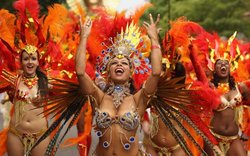
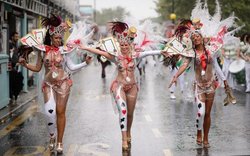
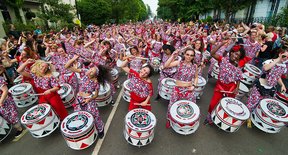
Robin Hood Festival in Sherwood Forest
For the week of August each year, in celebration of Nottinghamshire’s legendary outlaw, Sherwood Forest is transported back to the thirteenth century. Over a quarter of a century, the Robin Hood Festival has grown into a pop-up village of sorts, with stalls and attractions spread across about a square half-mile of woodland that can be circumnavigated comfortably in an hour or so.
The itinerary changes a little every day but archery lessons are always on offer for a small fee, and most days host high-octane jousting and rather vicious skirmishing between Robin Hood and the evil Sheriff’s men in the shade of the Major Oak, a gargantuan tree said to be over 800 years old, which attracts many visitors in its own right. The festival is a paradise for little boys and girls who have always dreamed of being Robin Hood or Maid Marian. Green felt caps, bows and arrows and garlands of flowers are ubiquitous fancy-dress props, and every day there are opportunities for children to join in theatrical re-enactments of the Robin Hood story, to the hilarity of their parents.
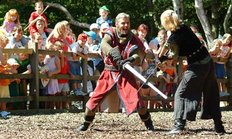
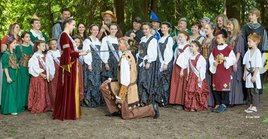
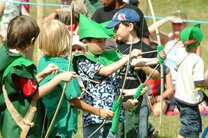
Guy Fawkes Night / Bonfire Night
An annual commemoration observed on 5 November, primarily in Great Britain, Guy Fawkes Night’s history begins with the events of 5 November 1605, when Guy Fawkes, a member of the Gunpowder Plot, was arrested while guarding explosives the plotters had placed beneath the House of Lords. Celebrating the fact that King James I had survived the attempt on his life, people lit bonfires around London, and months later the introduction of the Observance of 5th November Act enforced an annual public day of thanksgiving for the plot's failure.
Within a few decades Gunpowder Treason Day, as it was known, became the predominant English state commemoration, but as it carried strong Protestant religious overtones it also became a focus for anti-Catholic sentiment. Puritans delivered sermons regarding the perceived dangers of popery, while during increasingly raucous celebrations common folk burnt effigies of popular hate-figures, such as the pope. Towards the end of the 18th century reports appear of children begging for money with effigies of Guy Fawkes (“penny for the Guy”) and 5 November gradually became known as Guy Fawkes Day.
The present-day Guy Fawkes Night is usually celebrated at large organised events, centred on a bonfire and extravagant firework displays, prisoners / pirates /monks clothing and the famous mask of the Anonymous.
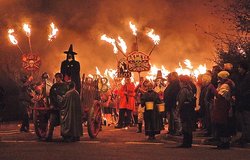
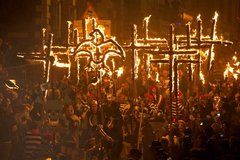
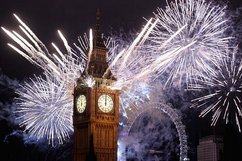


THE CARNIVAL OF VENICE, ITALY
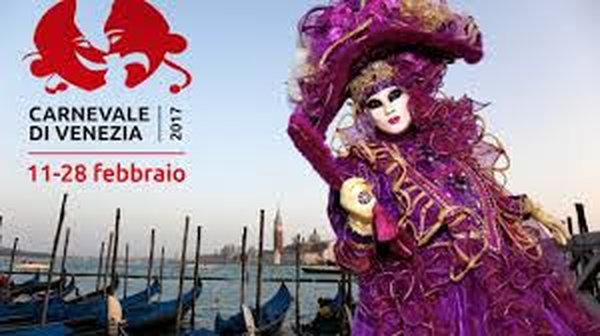
One of the most spectacular carnivals in Europe is the Carnival of Venice or The “Carnevale” as it is called - the biggest celebrations in Italyfrom Venetian masks to masquerade balls, no place does it like Venice!
According to tradition, Venice’s Carnival got its start in 1162, when townspeople celebrated a victory over the Patriarch of Aquileia. The festivities declined during the 16th century but by the 18th century, Venetians were celebrating Carnevale in style!
Another interesting fact is also the tradition of masking that has a long story in Venice. All the way back in 1268, a law even was passed to ban—of all things—putting on masks and throwing perfumed eggs! By the time of the Renaissance, masks were a fixture of Carnevale celebrations. The popular Commedia d’Arte troupe performed slapstick comedy in the piazzas of Venice while wearing masked and by the 18th century, Venetians were allowed to wear masks for six months a year. And what an extravaganza that was! Black velvet masks, for example, would be worn in “houses of ill repute”—especially gambling parlors—to shield their owners’ identities!
Today, Carnevale in Venice is a huge celebration that goes on for two weeks. While many events—particularly the opulent masquerade balls—require invitations and have steep ticket prices, many others, like the candle-lit parade of boats, concerts, and street performances, are free and open to the public. It is all about the costumes and masks and the amazing combination of colours, fabrics and limitless imagination!
